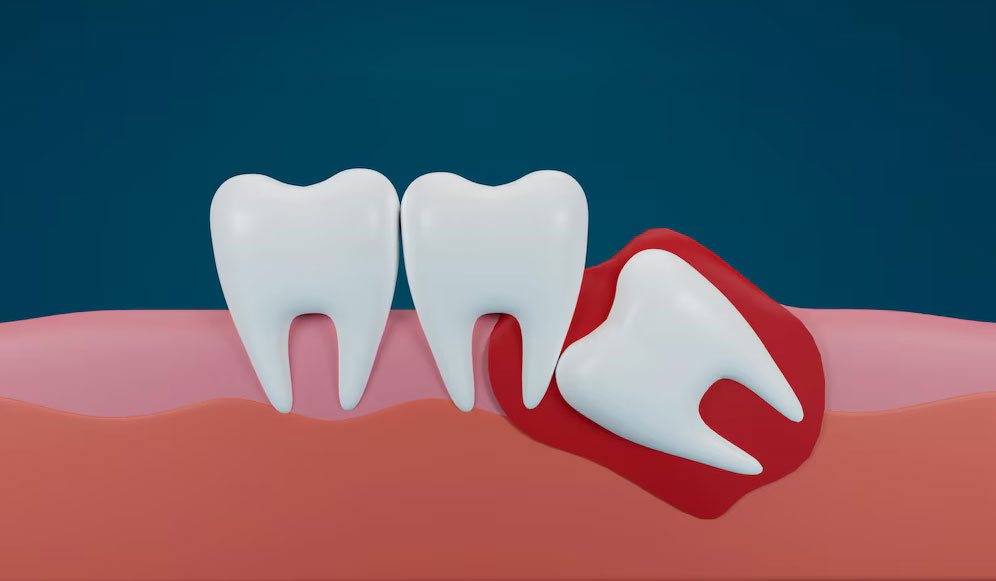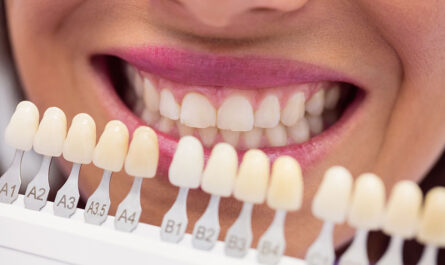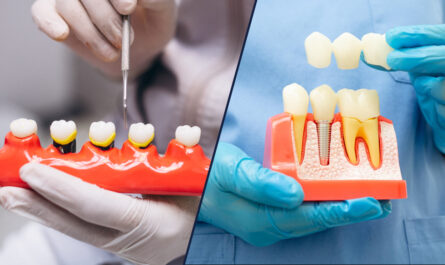Wisdom teeth, or third molars, erupt between ages 17 and 25. While some patients experience no issues, many require extraction due to impaction, crowding, decay, or infection. This guide covers everything—from indications and procedure to after-care, complications and real patient experience.
1. Why Remove Wisdom Teeth?
- Impaction: Tooth trapped under gum/bone
- Crowding: Pushing on adjacent teeth
- Decay/Infection: Hard-to-clean areas leading to pericoronitis
- Cyst Formation: Rare but serious jaw cysts
2. Surgical v/s Non-surgical wisdom tooth extraction: which one do you need?
Depending on the position of the wisdom tooth in the mouth, Dr. Irfana and her team decide after careful clinical and radiographic examination whether the tooth should be extracted surgically or non-surgically.
If the tooth is fully erupted, most of the time the extraction is non-surgical. More often than not, even mesially tilted wisdom teeth can be extracted non-surgically.
Typically, if the tooth is in the horizontal, vertical or distal direction and/or is covered by bone and soft tissue which interfere with the path of removal, then surgical extraction is advised to facilitate the extraction of wisdom tooth without damaging the surrounding tissues.
Types of Impaction
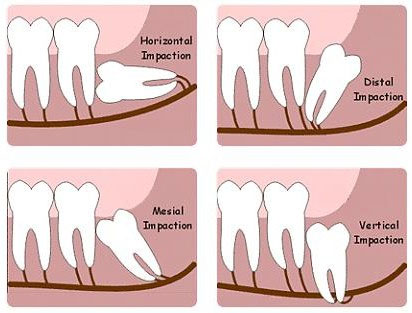
Refer to the clinical diagram above, which illustrates the four common impaction patterns:
- Vertical
- Mesioangular
- Distoangular
- Horizontal
3. Signs You Might Need Extraction
- Jaw pain or swelling
- Red, swollen, or bleeding gums
- Difficulty opening mouth or chewing
- Chronic bad breath or unpleasant taste
4. Procedure Overview
- Assessment & Imaging: Clinical exam + panoramic X-rays
- Anesthesia: Local anesthesia ± sedation
- Extraction
-
- Simple: Fully erupted tooth
- Surgical: Flap elevation, bone removal for impacted teeth
- Closure: Sutures as needed
- Duration: Typically 30–60 minutes
5. Real Patient Case
Case 1 – Patient 40/F visited Dr. Irfana’s Dental Studio with the chief complaint of pain in lower left wisdom tooth region.
On examination, it was observed that the tooth was decayed and after understanding the pros and cons of the treatment, it was decided that the wisdom tooth would be extracted.
Patient was advised to take medication as prescribed a day prior to extraction. The procedure was completed in under 30 mins. The patient did not complain of any pain during or even after the extraction at the follow-up visit. The healing was smooth, painless and uneventful.
Click here to read a patient review
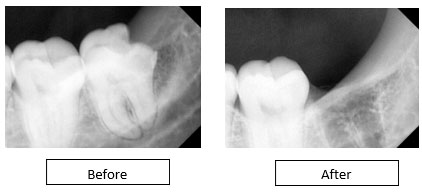
Case 2 – Patient 38/F visited Dr. Irfana’s Dental Studio with a complaint of pain in the lower right back tooth region.
On examination, it was observed that the wisdom tooth was horizontal in direction and required surgical extraction.
Patient was advised to take medication as prescribed a day prior to extraction. The surgical procedure was completed in under 45 mins. The patient has shared her experience on our GMB page.
Click here to read a patient review
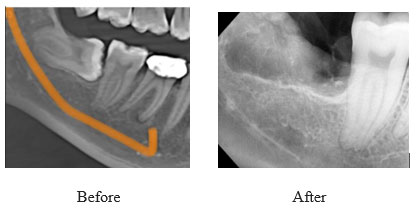
6. Post-Op Care or Recovery tips for faster healing
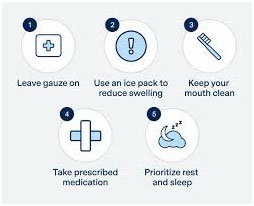
Key Steps
- Keep gauze in place for 30–60 minutes
- Use ice packs intermittently on the same day after tooth removal
- Rinse gently with warm saltwater starting Day 2
- Take prescribed medications on schedule
- Rest and elevate your head
7. What are the expected signs of normal healing during the first few days post-surgery
Day 1-2:
- Bleeding: Some bleeding is normal immediately after the surgery. It should gradually decrease within the first 24-48 hours. Gently biting down on gauze can help control bleeding.
- Swelling: Swelling around the extraction sites and cheeks usually peaks around the second or third day post-surgery and then gradually begins to decrease.
- Pain: Pain and discomfort are expected, especially in the first 48 hours. The prescribed pain medications or over-the-counter pain relievers can help manage this discomfort.
- Limited Mouth Opening: Some difficulty in fully opening your mouth due to swelling and muscle stiffness.
- Bruising: Minor bruising of the cheeks or jaw may appear, especially if impacted wisdom teeth require more extensive surgery.
Day 3-4:
- Reduced Bleeding: Bleeding should significantly decrease by this point. If bleeding persists or increases after the first couple of days, contact your oral surgeon or dentist.
- Decreased Swelling: Swelling may still be present but should start to diminish.
- Continued Discomfort: Pain and discomfort should gradually lessen but may still be present. It’s common for the discomfort to peak around this time.
- Starting to Eat Soft Foods: You can typically begin incorporating soft foods into your diet if advised by your dental professional.
Day 5-7:
- Continued Healing: The extraction sites might start to feel better, and the tissue around the sockets may appear less irritated.
- Decreased Pain: Pain and discomfort should continue to improve.
- Reduced Swelling: Swelling should noticeably decrease compared to the earlier days.
- Resuming Normal Activities: You may start feeling more comfortable with regular activities but still need to avoid strenuous exercise or activities that may hinder healing.
Remember, these timelines can vary from person to person, and some individuals may experience a faster or slower healing process. If you notice any unusual or concerning symptoms, such as severe bleeding, increasing pain, persistent swelling, or fever, it’s essential to contact your oral surgeon or dentist for further evaluation and guidance.
8. Common Complications & Statistics
| Complication | Incidence |
|---|---|
| Dry Socket (Alveolar Osteitis) | 0.5–5% of routine extractions; 25–30% for impacted mandibular third molars |
| Post-op Infection | ~1.4% of extractions |
| Inferior Alveolar Nerve Injury | Temporary in ~6% of cases; permanent ~0.6% |
| Lingual Nerve Injury | Permanent in ~0.5% of cases |
Prevention & Management
- Dry Socket: Avoid smoking, straws, spitting; consider topical antifibrinolytics
- Infection: Maintain oral hygiene; antibiotics as indicated
- Nerve Injury: Pre-op imaging, coronectomy option for high-risk patients
9. Final Thoughts
Wisdom tooth extraction is a common, generally safe procedure that—when done at the right time—prevents pain, infection, and damage to neighboring teeth. Early evaluation, clear patient education, and careful after-care are the keys to a smooth experience.
Ready to take the next step? Schedule your consultation at Dr. Irfana’s Dental Studio today. Your smile is in expert hands.
FAQs
1. When can I expect the swelling to peak, and how long will it take for the swelling to subside?
Post wisdom teeth removal, the swelling typically peaks around the 2nd or 3rd day post-surgery. After that peak, the swelling gradually starts to decrease.
The timeline for swelling to subside varies from one individual to another. Generally, after reaching its peak, it takes about 3 to 5 days for the swelling to noticeably reduce. However, complete resolution of swelling might take a week or longer for some individuals.
Even though swelling is a normal part of the healing process, it is important to be aware that if it persists or worsens beyond the first few days, or if it’s accompanied by severe pain, fever, or other concerning symptoms, it’s advisable to contact your dental professional for further evaluation. They can provide guidance and ensure that the healing process is progressing as expected.
2. How long should I continue to take prescribed pain medications, and when can I expect a decrease in pain levels?
Depending on individual pain tolerance, the complexity of the extraction, and the healing progress, the duration of taking prescribed medication will vary. Normally, these medications are often required for the first few days post-surgery when pain and discomfort are most intense. Typically, you can expect a gradual decrease in pain levels within the initial 48 to 72 hours. As the healing progresses, you may find that you require less potent pain relief, transitioning from prescription medication to over-the-counter pain relievers like ibuprofen or acetaminophen. It’s important to follow the dosage instructions provided by your oral surgeon or dentist and consult them if the prescribed pain medication doesn’t seem to alleviate your discomfort adequately or if you experience unexpected side effects.
3. When is it safe to brush my teeth normally after surgery?
After wisdom tooth removal, you should refrain from brushing around the surgical site for 24 hours to allow the initial blood clot to form and prevent any disturbance to the extraction site. After this initial period, you can resume brushing your teeth including the surrounding areas gently using a soft-bristled toothbrush. It’s crucial to be extremely careful and gentle while brushing to avoid the dislodgement of the blood clot or cause irritation to the healing tissues. Always follow the specific post-operative instructions given by Dr. Irfana to ensure proper healing and oral hygiene during the recovery period.
4. At what point can I resume regular activities like exercising or going back to work or school?
Resuming daily activities like going to work, school or exercising after extraction of wisdom tooth depends on various factors such as the complexity of the surgery, individual healing and the nature of your daily activities. In general, it is recommended that you take it easy for at least 24-48 hours post-surgery to allow initial healing and manage discomfort.
If your pain is manageable after this initial period and there are no complications, you can gradually begin to resume light activities as tolerated.
However, strenuous activities and exercises that could potentially disrupt the healing process should be avoided for at least a week until the dentist gives you clearance. Returning to work or school depends on how you feel; many individuals can resume sedentary tasks after a couple of days, while ones which involve physical activity should be delayed based on the instructions given by Dr. Irfana and her team after assessing your recovery.
5. How long before I can use a straw, consume hot liquids or smoke after wisdom teeth removal?
It’s generally recommended to avoid using a straw for drinking fluids after wisdom tooth removal for at least the first few days. The suction created while using a straw can dislodge the initially formed blood clot, thereby leading to a condition known as ‘dry socket’ which can be quite painful.
Additionally, it is advisable to avoid consuming hot liquids during the initial healing phase as they can increase blood flow to the surgical site, potentially causing bleeding or irritation.
Smoking should also be avoided for at least a few days to a few weeks post-surgery. The suction and chemicals from smoking can impede the healing process and increase the risk of complications including infection and delayed healing. It’s crucial to follow the specific guidelines provided by Dr. Irfana’s Dental Studio for smooth recovery.
